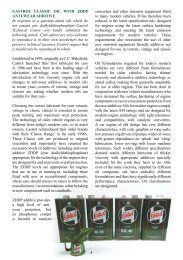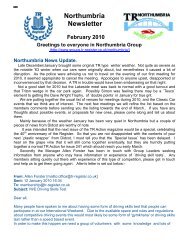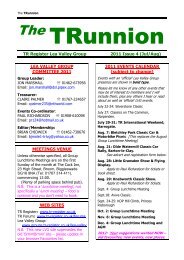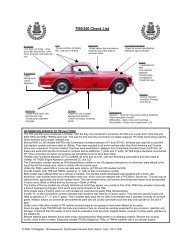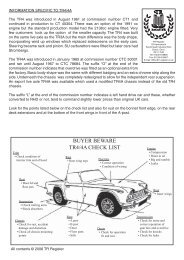Trunnion 20134_trweb.pdf - the TR Register Groups Portal
Trunnion 20134_trweb.pdf - the TR Register Groups Portal
Trunnion 20134_trweb.pdf - the TR Register Groups Portal
You also want an ePaper? Increase the reach of your titles
YUMPU automatically turns print PDFs into web optimized ePapers that Google loves.
12 The <strong>TR</strong>unnion<br />
How To Improve Triumph Handbrake Operation<br />
From Tim Hunt<br />
The early <strong>TR</strong>s from 2 to 4 had long traditional<br />
fly-off handbrake levers positioned on <strong>the</strong><br />
right hand side of <strong>the</strong> gearbox cover. The<br />
long lever gave a good mechanical<br />
advantage and an efficient handbrake<br />
operation. However, in RHD cars longer<br />
legged drivers found <strong>the</strong> lever rubbing<br />
against <strong>the</strong>ir left leg and often resorted to<br />
fitting foam round <strong>the</strong> lever for more comfort.<br />
Triumph eventually responded to this<br />
criticism and on <strong>the</strong> <strong>TR</strong>4A, whilst <strong>the</strong> fly-off<br />
action was retained <strong>the</strong> lever was moved to<br />
<strong>the</strong> more usual position on top of <strong>the</strong><br />
transmission tunnel, between <strong>the</strong> seats.<br />
Unfortunately <strong>the</strong> lever had of course to be a<br />
lot shorter than on <strong>the</strong> earlier cars, affording<br />
significantly less leverage. Indeed, <strong>the</strong><br />
Autocar road test of <strong>the</strong> 4A in March 1965<br />
reported that <strong>the</strong> handbrake was not secure<br />
on anything steeper than a 1-in-4.<br />
Way back in <strong>the</strong> early 70s I happened to<br />
mention <strong>the</strong> poor handbrake action to a<br />
service technician from <strong>the</strong> old Broadfields<br />
garage in Cockfosters. He told me of a<br />
bulletin from <strong>the</strong> factory that had addressed a<br />
similar concern in relation to poor handbrake<br />
efficiency on <strong>the</strong> Herald and <strong>the</strong>re was no<br />
reason why <strong>the</strong> recommended modification<br />
should not work on <strong>the</strong> similar 4A handbrake.<br />
All that is required is to remove <strong>the</strong><br />
handbrake lever, take off <strong>the</strong> compensator<br />
link and drill a new hole for this 7/16” closer<br />
to <strong>the</strong> fulcrum pin (see photo). The two<br />
ra<strong>the</strong>r unsightly bits of rubber tubing stuck on<br />
<strong>the</strong> lever are simply to prevent <strong>the</strong> handbrake<br />
gaiter being damaged by sharp metal edges.<br />
A simple calculation shows that for a given<br />
force applied to <strong>the</strong> lever <strong>the</strong> force applied to<br />
<strong>the</strong> handbrake cables is increased by around<br />
30% by this simple dodge! The minimal<br />
downside is of course that for a given<br />
movement of <strong>the</strong> cables <strong>the</strong> lever has to<br />
move through a somewhat bigger arc.<br />
Many Triumph models have a similar<br />
handbrake design and could benefit in <strong>the</strong><br />
same way. The <strong>TR</strong>5 and 6 handbrake is<br />
identical to <strong>the</strong> 4A and, indeed, <strong>the</strong> Autocar<br />
<strong>TR</strong>6 road test of April 1969 mentioned that a<br />
mighty heave was needed to hold <strong>the</strong> car on<br />
a 1-in-4 and <strong>the</strong> handbrake would simply not<br />
hold <strong>the</strong> car on a 1-in-3. A road test of <strong>the</strong><br />
GT6 Mk II from <strong>the</strong> same month similarly<br />
reported that <strong>the</strong> handbrake could not hold<br />
that car on a 1-in-3 and felt none too secure<br />
on a 1-in-4. My modified handbrake holds<br />
<strong>the</strong> car securely on <strong>the</strong> steepest hills and I<br />
suggest anyone unhappy with <strong>the</strong>ir<br />
handbrake performance should consider this<br />
simple modification.<br />
Figure 1 Repositioned compensator link on<br />
<strong>TR</strong>4A handbrake lever<br />
~~~<br />
Many thanks for that Tim. The poor<br />
handbrake on <strong>TR</strong>4A-6 has been discussed<br />
frequently on <strong>the</strong> <strong>TR</strong> Forum. Even with<br />
everything perfectly adjusted, many find <strong>the</strong><br />
performance is marginal and to avoid<br />
frequent adjustment, some modification is<br />
advisable. This solution is far simpler than<br />
fabricating <strong>the</strong> alternative link extension to<br />
<strong>the</strong> brake back-plate lever as described in<br />
Roger Williams' "How to Improve <strong>TR</strong>2-4A".<br />
~~~<br />
Also from Tim Hunt:<br />
Brian,<br />
I attach details of <strong>the</strong> Classic Meet to be held<br />
in Pirton from 16.00 on Thursday 8th August<br />
with all proceeds to <strong>the</strong> RNLI. Hopefully you<br />
can reproduce in <strong>the</strong> imminent <strong>TR</strong>unnion. I<br />
plan to attend.<br />
[See below]



